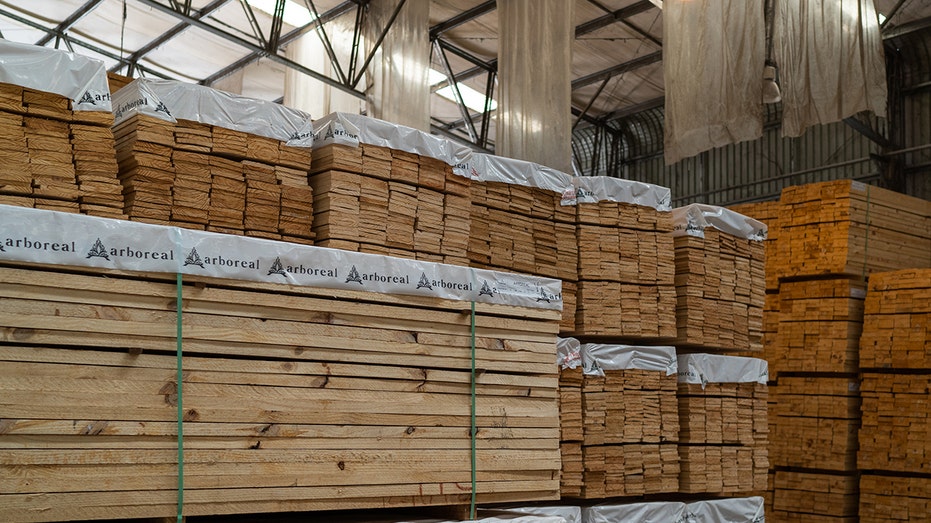Lumber prices are on the rise again
Random Lengths reported its framing composite index increased 65%
Fox Business Flash top headlines for December 20
Check out what's clicking on FoxBusiness.com.
Lumber prices have shot up again in a rise reminiscent of a year ago, when high-climbing wood prices warned of the hinky supply lines and broad inflation to come.
Futures for January delivery ended Friday at $1,089.10 per thousand board feet, twice the price for a prompt delivery in mid-November.
Cash prices are way up as well. Pricing service Random Lengths said that its framing composite index, which tracks on-the-spot sales, has jumped 65% since October, to $915. A $129 gain this week was the biggest on record, eclipsing a $124 jump in May, when lumber prices crested at all-time highs.
NORTH CAROLINA QVC EMPLOYEE DIES IN MASSIVE DISTRIBUTION CENTER FIRE

Lumber at the Arboreal sawmill in Tacuarembo, Uruguay, on Thursday, Oct. 28, 2021. (Ana Ferreira/Bloomberg via Getty Images / Getty Images)
Though lumber is traded in esoteric markets, two-by-fours became a proxy in the debate over whether inflation would fade with distance from the lockdown. In June, Federal Reserve Chairman Jerome Powell pointed to lumber prices plunging from a shocking peak as evidence that surging costs would subside. On Wednesday, he said the central bank would hasten the wind down of its bond-buying program, setting the stage for a series of interest-rate hikes meant to tame inflation.
Lumber prices have a way to go before they threaten the records set in spring, when futures hit $1,711.20. Still, lumber prices with a comma were unimaginable before the lockdown, when mills were caught off guard by do-it-yourself and home-building booms and all the decks needed to facilitate outdoor dining.
Analysts and traders say conditions are ripe for prices to keep climbing through winter, as they often do ahead of the spring building season.
Flooding in British Columbia has cut off sawmills from forests and customers, unusually warm autumn weather has extended the building season and wood buyers are loading up in fear of further price increases and supply problems.
The prospect of higher interest rates cooling the hot housing market also looms. Higher borrowing costs would reduce buyers’ ability to keep up with the price hikes that builders have used to offset their own increased costs. Most Fed officials have penciled in at least three quarter-percentage point rate increases next year.
"Builders think that they’re getting close to the end of a cycle and they’re doing everything they can to get houses going," said Matt Layman, an analyst and consultant who publishes Layman’s Lumber Guide. "They know they can pay $1,500 for two-by-fours. They didn’t like it, but it didn’t hurt them."
Random Lengths said that demand has exceeded supply, prompting sawmills to aggressively raise prices in hopes of slowing orders that are backing up into the new year. "Some producers unable to dissuade buyers with defensive pricing went off the market," the trade publication said.
Sawmills in British Columbia have reduced output since rains washed out roads and railways last month, sending prices higher for the northwest’s spruce, pine and fir. Busy builders hammering away through balmy fall weather flocked to eastern markets for wood, pushing up prices around the Great Lakes and in the South.
In a recent survey of building-product dealers, 20% of respondents told John Burns Real Estate Consulting that they held what they deemed to be excess inventory of lumber, down from 56% who said in August that they had more than enough on hand.
The firm expects home construction to accelerate in 2022 and strong growth in major remodeling jobs due to the record amount of home equity available to pay for new kitchens and additions.
CLICK HERE TO GET FOX BUSINESS ON THE GO
"They should be sitting on more inventory," said Todd Tomalak, who tracks building products for the consulting firm. "It’s the perfect storm for another wave of building-product shortages, a rinse and repeat in lumber and for a lot of other stuff as well."

Kiln-dried hardwood lumber inside a sawmill at Harold White Lumber in Morehead, Kentucky, on Wednesday, Aug. 4, 2021. (Luke Sharrett/Bloomberg via Getty Images / Getty Images)
On Wednesday, the National Association of Home Builders said its index of builder confidence, though down slightly from last autumn’s peak exuberance, hit one of its most optimistic readings dating back to 1985. On Thursday, the Commerce Department said that construction started on 1.679 million homes last month at a seasonally adjusted annual rate. That is up 12% from October and the most since March.
The number of started homes exceeded those that were completed by the largest margin since 1984, when double-digit mortgage rates tanked the housing market. The big gap reflects the difficulty builders have had procuring materials, appliances and fixtures necessary to finish houses.
Builders have had no trouble raising prices to counteract their own increased costs, because ultralow mortgage rates have kept monthly payments affordable. Despite record prices for lumber and other materials, home builders have been reporting some of their highest profit margins ever.
CLICK HERE TO READ MORE ON FOX BUSINESS
Builders including Toll Brothers Inc. , Lennar Corp and Hovnanian Enterprises Inc. say they are still working through the lumber bought when prices peaked in spring and expect margins to increase later next year when they sell houses built with wood purchased after prices crashed back to earth this summer. Executives with those firms told investors during recent calls that they are confident they can raise home prices more if lumber makes another run.
"The market just feels really strong regarding pricing opportunities, so we’re comfortable," said Ara Hovnanian, chief executive of his eponymous firm, which sold homes for an average price of about $445,000 in the fiscal year that ended Oct. 31, compared with roughly $419,000 a year earlier.




















